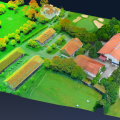
The ambitious, unprecedentedly vast Square Kilometre Array project should open up new realms in astrophysics, reports John Matson in the Scientific American. But will it live up to its name?
The Boolardy homestead in Murchison, WA, is occupied by a rotating cast of engineers, construction workers, scientists and, now, four North American reporters on a government-sponsored visit. Federal and state agencies plunked down about $5 million to purchase some 3,500 square kilometres of this rangeland in 2009, then signed a land-use agreement with the indigenous Wajarri Yamatji people worth more than $18 million to allow for construction on a core region of almost 130 square kilometres. Since that time, the site has seen numerous upgrades in power generation, water storage and high-speed communication infrastructure. The dirt roads leading from the homestead to the core of the site have been graded to a flatness and smoothness that rivals most highways.
Nine thousand kilometres to the west, across the Indian Ocean, a similar scene is unfolding. Near the town of Carnarvon in the Karoo region of South Africa, a government-backed project has acquired 140 square kilometres of farmland about 450 kilometres northeast of Cape Town. Surrounding the remote plot is a newly-designated 125,000-square-kilometre protected reserve. Like Murchison, the Karoo site has undergone a progressive makeover since its 2008 purchase—better roads, new fibre-optic cables, new power lines—to become ever more incongruous with its rugged surroundings.
The multibillion-dollar reason for all this parallel activity in Australia and South Africa has recently become clearer. At each of the far-flung sites, a handful of radio telescopes has sprung up like clusters of white mushrooms blooming from the red earth. Radio telescopes, receive emissions from space at the longest wavelengths on the electromagnetic spectrum. Those emissions may come from natural radio sources in the galaxy, such as the spinning stellar remnants known as pulsars, or may originate as shorter-wavelength signals, such was microwaves, that have been stretched into the radio band as they travel from distant sources, across an expanding universe, to reach Earth.
Australia has six dishes, with designs on 30 more; South Africa has built seven of a planned 64. When the two projects, the Australian Square Kilometre Array Pathfinder (ASKAP) and the Karoo Array Telescope (MeerKAT), are finished, each will be among the most powerful radio observatories in the world. But both countries have set their sights on a bigger prize. South Africa is building MeerKAT, and Australia is building ASKAP, in the hopes of landing the $2-billion Square Kilometre Array, one of the most ambitious telescope projects in history.
In 2012, an international consortium will choose Murchison or Karoo as the home of the Square Kilometre Array, or SKA, a vast network of 15-meter radio telescopes that, as proposed, would comprise 3,000 steerable dishes that pivot on multiple axes to aim at celestial targets. With an array of interconnected dishes, astronomers can yoke all the telescopes together, essentially combining the collective observing power of the group into one super telescope. Adding more collecting area—that is, building more dishes—boosts the array's sensitivity, whereas spacing the dishes out across great distances gives the array better resolution.
You can read the full article here.







